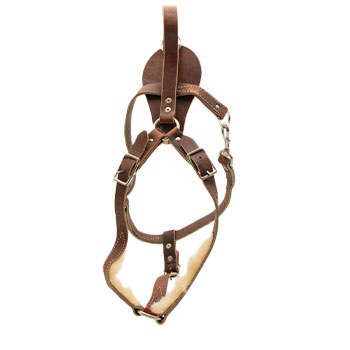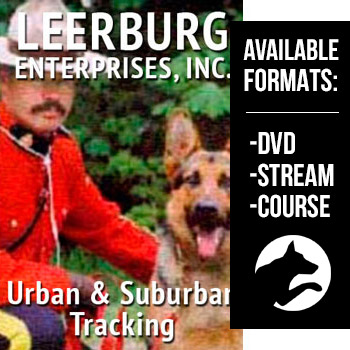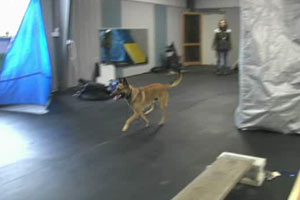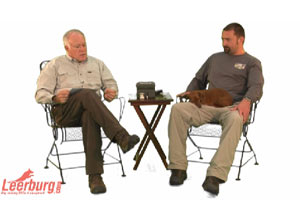The Tracking Wall and How to Get Over It
Ed's Note: Gary Murray is a friend of mine. He is a retired Royal Canadian Mounted Police (RCMP) dog handler with 17 years of experience running tracking dogs for the RCMP. He currently owns and operates a kennel and training facility in Alberta. He sponsors tracking seminars for police and S.A.R. at his facility several times per year. If you are a K-9 handler or S.A.R. volunteer, I highly recommend Gary's seminars. You will come away from his seminars a better dog handler and trainer. —Ed Frawley
As dog handlers, we all have handled dogs that seem to hit a point in their training that to us appears to be the limit of their abilities "the wall." Sometimes that is true but a greater percentage of the time it is not. Being the thinking end of the leash it is our responsibility to try and figure out just what the problem is. To break it down to its smallest component and adjust our training so we can train through the wall and progress with our training even further or except the fact that we as a team have indeed reached our limits.
With tracking the first place you would go to is your training logs. Here you will need to make an HONEST evaluation of the progress you have made to date. Sometimes this is a hard thing to do and you would be better off having an experienced handler help you with this evaluation.
As you have the experienced handler there you might as well have him/her do a couple of training tracks with you so your handling skills may also be looked at. At the same time the dog may be assessed to see if there is any problem with the dog.
You noticed that the first two areas I mentioned were the handler and what they may be doing wrong. The reason that I did that is because almost always it is the two legged part of the team that is the problem. If it is not your fault then in all likely hood it was the guy/gal who raised the dog's fault. Breeding can only provide you with the raw material it is up to us to produce the working dog.
Some of the obvious areas that can be observed in the tracking log is over training. We and our departments sometimes put time restrictions on our training periods which our dogs can not handle. If this is the case a few days locked up in a kennel with no work at all can solve a lot of problems.
Progressing too fast is another area that is a result of time pressures from us and our departments. Remember you are training a dog not a machine, march to his/her drum not your own. This is an area that can be solved by time off or just backing your training up a bit. Do some fresher, shorter, easier tracks to bring the motivation back up.
Training at the wrong time or in the wrong conditions will also be reflected in your tracking log. Our dogs are going to have to work under all conditions that is a given, but when you are training a dog it is to learn something. So you are to make the training session such that the dog has the best chance of learning just what it is you are trying to teach him/her. If you are working on distance then don't train in the heat of the day. If you are working on visual distractions don't work the dog at 03:00 hours in the morning when there is nothing to distract the dog.
Variety in training is also a very important area to look at in our training logs. Some dogs will progress quite well with each track getting harder and harder, longer, older, etc. But variety is the spice of life and this also applies to dogs. This especially holds true when you are on heavy training schedule as on a training course and working 5 days a week. Throw the odd fresh track or short track or no track at the dog to keep him/her guessing. Use only 2 days for progress days in your training, then 2 days at the same level, then one short fast day. Or put the short fast day in the middle but change it up to keep the motivation up.
The hardest part of being a dog handler is self evaluation. That is why I advised at the beginning of this article to seek out an experienced dog handler to help you out with your evaluation when you hit the wall. Once at the wall your frustration will be mirrored in your dog and if you are not careful you will make the wall a lot bigger than it probably should be. May be your training logs will show you that you have been working too hard. Your dog may be able to handle the pressure of the work but you can't so you start to snap and this is reflected onto the dog and the reality is you are the problem not the dog. Don't get mad at the dog because you have made a mistake.
The Wall as it applies to dogs who have completed training and are working, is Department or Organization imposed. By this I mean the standards that we train to. As soon as you put down in writing and test to a set standard you put up a wall most dog handlers won't cross. Don't sell your dog and your self so short. These standards are a minimums set by people. Don't work your dog, work with him/her, let them take you far beyond where you think you can go. If the standard says 1/2 mile, go a mile 1/2 , if the standard says 20-30 minutes old, go 45-1 hour, if the standard says in an open field with medium length grass, go into town and back alleys. You can cross the Wall.
If you can not detect a problem in the tracking log you may have a problem with the dog. There is the reality of a dog that is just not cut out for this line of training. Some dogs are meant to lay at their masters feet and that is all. Good research into the breeding of the dog should eliminate this area. But the key is how, who and where the dog was raised. That first year of a dog's life is the most important year of his/her life, it will make or brake what a dog becomes. So know your dogs history.
There is also the medical condition of your dog. So make sure there is no problem with your dogs health or fitness. There are some minor medical problems where the dog can still be worked but is on medication. Some of these medications can affect your dogs ability to smell. So check with your Vet to make sure there is no problems in this area.
Now that you have had a chance to determine just what the problem is we should cover some methods to use to get us past the Wall. The statement "Tracking's Wall" infers that and assumes that the dog has the ability to track and has reached a point where there is no improvement in the dogs ability to track.
We should be able to classify the cause into one of four categories: 1) the handler, 2) the dog, 3) track aspects, or 4) Motivation.
The first two, the handler and the dog, we have touched on earlier in the article. We will not go into great details but the handler has to be able to do an honest self evaluation. With out that or the assistance of an experienced trainer the team will not be able to make any real progress. The reality of it is handler selection is as important as the dog selection.
The dog at this point and time has shown the ability to track or would not have gotten this far. So in all likely hood the problem falls in areas 1), 2), or 3). If on the off chance that it is the dog. Make sure that the decision is made after the dog is checked out by a Vet and been evaluated by other experienced handlers before you give up on the dog. This dog may not work for you but would work for someone else.
If it is one of the aspects of the track that the dog is having problems with there are two thing to be done in order to deal with this problem. Firstly isolate the aspect and train to it. By aspects I mean distance, age, articles, corners, road crosses, cross tracks, distractions(scent, audio, visual, animal). As with all dog training you break down what you want to train to it's simplest part, train each part and then put it all together. This way the dog learns and understands just what it is you are trying to get him/her to do.
For example: If distance is the problem remove all the other aspects of the track that make it more difficult for the dog to accomplish the distance part (corners, distractions, road crossings, cross tracks, difficult surfaces, etc.) Now use the things that will help the dog go the distance, (good tracking surface, rested dog, enthusiastic handler, fresh track, praise, etc.) to your advantage.
If animal distraction is a problem remove all the other aspects of the track that make it more difficult for the dog to pass by an animal (corner by the animal, road crossings by an animal, age, difficult surfaces, sect.) Now use the things that will help the dog go past an animal and not distract (very fresh track, good tracking surface, rested dog, animal a ways off the track, good line work and praise). Animal distractions can be broken down into an even simpler aspect and trained for outside of tracking. If your dog has an animal problem while tracking he/she will also have an animal problem when exposed to other animals. So find the animal you are having trouble with expose your dog to it using corrections if the dog is not acting properly. Once mastered then progress to obedience around the animal, corrections if necessary. Once mastered then back onto tracking by the animal.
The fourth and last area to cover is motivation. Your dog would have had no problems in this area before you got to "the wall." Because of some problem which started for what ever reason that created the wall there is a good chance that it will affect the dogs motivation. As mentioned before this could be because of over training, progressing too fast, problems with aspects of the track, lack of success, handler frustration any number of things.
To motivate a dog at this point in the training can be done by a number of different ways but most of them are just a change in the training routine that the dog views as a positive or in simple terms enjoys.
Fresh tracks is one of the simplest ways to motivate a dog. When things are going wrong it feels like you are taking one step forward and two steps back. So you just reverse the steps and take two steps back to get one step forward. If the dog is progressing and then hits the wall before things get worse back his/her tracking level up to a point where you know the dog will have no problem. (The old training adage "Always end on a positive"). Shorter, fresher, easier tracks then when things are going well make the progression onto harder tracks slower than what you had been progressing at.
You may use fresh tracks to help with getting distance out of a dog. This can be done two ways. One lay the whole track and work it while it is fresh, each time pulling more distance out of the dog. Another way which allows you to keep the dog working tracks that are a little older, is to work an older track at the time and distance that you know the dog can do. Then have the quarry finish off the last additional leg (adding distance to what the dog can do) just minutes before the dog gets to the end of the old part of the track.
A good trick to motivate a dog and still work a track that is older is to lay the track and let it age. When you go to work the track post the dog on one side of a vehicle. Then have the quarry (Track layer) tease the dog up just before you start the track. The quarry then runs around the vehicle and slips into the vehicle while the dog is still posted out of sight on the other side. The handler then runs the dog wide around the vehicle with lots of enthusiasm to the starting point of the track and starts the track.
Articles are another way of motivating a dog. This works best with dogs that have been trained to aggress or play with a track related article. Instead of the normal 2-4 articles on a track you can load the track up with 6-10 articles with lots of praise at each article. This will help pull the dog along the track and can be used for both age and distance. The article placement can be just after a tough aspect of the track as a bit of a reward for working past this tough spot.
For police dogs you can also use aggression at the end of the track as a reward for finding the quarry. This will work on dogs who are strong attack dogs and weaker in tracking. This method you have to be careful with as there are some side effects that you have to watch for. You don't want to condition your dog to think that there is a bite at the end of every track. This could cause you problems in the control area. Using aggression can also lead to a dog that starts to anticipate a quarry jumping out from behind that car, that bush, that garage,....sect. This will cause to dog to lift his head and use his eyes which may lead to another problem. So be careful with this method.
A different type ending to a track with interaction with the quarry may also help motivate the dog. Rag the dog at the end of the track, play with the quarry with the dogs favorite toy, physical praise from the quarry. The fact that there is a live person at the end of a track is also the best way to teach tracking. Laying a track and leaving the ball at the end is not enough. Dogs track people not balls!
The ever eluding track is also a real good method to develop a dog and pull him/her past the wall. For rural tracking the quarry starts to walk and lay the track. You give the quarry a 2,5,7,10 minute head start and then you start to track. The quarry does not stop walking (you may, depending on your dog put a limit of time or distance) until the dog tracks up to him/her. The track being followed is always getting fresher as the dog tracks along it. In an urban situation (for Police Dogs) you may lay two legs of the track. Let it age to an age you know the dog can track. When the quarry sees the dog start the second leg of the track he/she runs and lays the third leg. When the quarry sees the dog start the third leg he/she runs and lays the fourth leg. The freshness of the last legs motivates the dog and pulls him/her along for greater distance and results.
These are just a few simple ideas to help you get past the wall. Remember identify the problem early, break it down to it's simplest component, train for that problem and get past the wall. Use your imagination, think like a dog and come up with a solution that helps you and your dog become a better team.










Ask Cindy.